Content Optimization Strategy: 20 Tips to Drive Leads and Traffic
Topic: SEO
Published:
Written by: Bernard Huang
When you hear the term “content optimization,” you probably think of all the techniques you can use to improve an individual piece of writing. But there’s a bigger picture to think about.
For the best results, you want to have an overall content optimization strategy. In other words, seeing the forest as well as the individual trees.
With a broad strategy, you can maximize the value of each piece of content by understanding how it fits with other posts and elements on your website.
As a result, you’ll create a website with consistently high-quality content that helps you build trust and credibility with potential customers.
Note: Clearscope is our product. We’re proud of what we’ve built and believe we have the best content optimization and monitoring platform on the market. Request a personalized demo.
What is content optimization?
Content optimization is using tactics to ensure that your content achieves your marketing goals. This can include improving your content in several ways. You may want to improve the quality of your content, its reach and visibility, or its ability to generate leads.
Content optimization is often associated with search engine optimization (SEO). SEO content optimization consists of adding SEO tactics to copywriting and content design to help you reach a wider audience. Specifically, these tactics help your content rank higher on search engine results pages (SERPs) for target keywords and improve your click-through rates (CTRs).
But of course ranking in search engines is not all there is to content marketing. You can also use content optimization tactics for other goals, such as building brand awareness through social media or generating conversions.
As a broad strategy, content optimization means that you apply these tactics to your website content to reach more of your target audience and meet their needs.
Why is content optimization important?
Content optimization offers several benefits for your website and business, such as increasing organic traffic, building brand awareness, and generating more leads.
If SEO is a part of your content strategy and you don’t optimize content for search engines, for example, you could put a lot of effort into writing pieces that no one sees.
In addition to the end results (such as traffic and leads), the content optimization process can help improve your website’s user experience and the quality of the information on your webpages.
That’s because search engines lead people to websites with positive user experiences that also deliver the most relevant and valuable content. Ultimately, the steps you take to improve your search engine rankings will improve the quality of your website.
You can use a content optimization strategy to achieve goals like:
Increasing organic website traffic
Improving brand awareness
Ranking higher on SERPs
Generating more leads
Increasing revenue
Types of content optimization
You can divide content optimization strategies into a few categories (or techniques), including on-page SEO, off-page SEO, conversion-optimization, and optimization for social shares.
Here’s a closer look at each:
On-page SEO: This technique uses the elements you have the most control over (like content, keyword usage, and media) to create high-quality content for your readers with valuable information to rank higher on search engines.
Off-page SEO: These are the steps you take to generate backlinks to your website and improve your domain authority. An example is writing an article with unique data that others will want to cite and link back to.
Optimizing for social shares: These strategies help you create content that will gain traffic from social media.
Conversion optimization: This is a way to create content that motivates readers to take an action, such as subscribing or making a purchase.
All of these techniques are related. So, leveraging a combination of them creates a more effective content optimization strategy.
SEO content optimization strategies
Find the right topics and keywords
Do competitive research
Write in-depth content
Optimize page title tags and URLs
Write compelling meta descriptions
Add engaging visuals
Build topic clusters
Refresh existing content
Improve your website’s UX
You can add these SEO content optimization strategies to your digital marketing plan to rank higher on SERPs and drive more organic traffic.
1. Find the right topics and keywords
Content optimization starts with planning. Specifically, it begins with identifying the topics you should write about and then researching target keywords within those categories.
The goal here is to find the overlap between the topics your audience cares about and the topics you have expertise on/those related to your product.
Clearscope’s Topic Exploration tool helps you identify content ideas within a topic. It shows you commonly asked questions, what’s trending, long-tail keywords, related terms, as well as identifying keywords a page is ranking for. You can organize results by search volume, competition level, and cost-per-click (CPC).
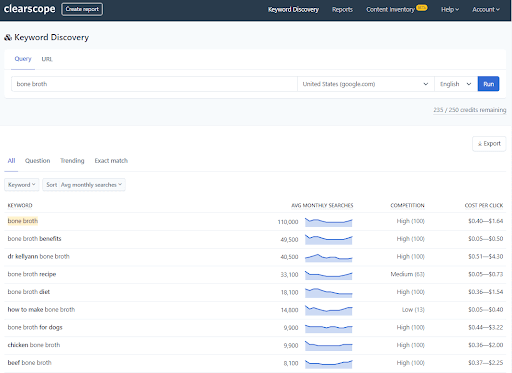
Clearscope Topic Exploration tool results for the keyword “bone broth.”
Your research should also include identifying the user intent behind each search query.
Including various types of search intent helps you create content to support all stages of the customer journey. For instance, low-intent keywords can bring more searchers to the top of the funnel. But high-intent keywords can attract readers at the bottom of the funnel who are more likely to convert.
2. Do competitive research
Competitive analysis is another essential step when creating new content. It’s especially helpful to do competitor research after you’ve found your target keywords and before you create SEO outlines or write drafts.
That’s because search engines are designed to provide the most relevant and valuable information. So, it’s important to know what’s already out there before you begin.
Specifically, you want to look at the top-ranking articles and figure out:
What topics and keywords do they use?
Which user intent do they optimize for?
How do they create value?
Clearscope’s Term map and Competitor tabs make it easy to analyze competitor content as you craft outlines. In one dashboard, you can easily compare the top-performing pieces’ keyword usage, word count, headline structure, and content optimization score.
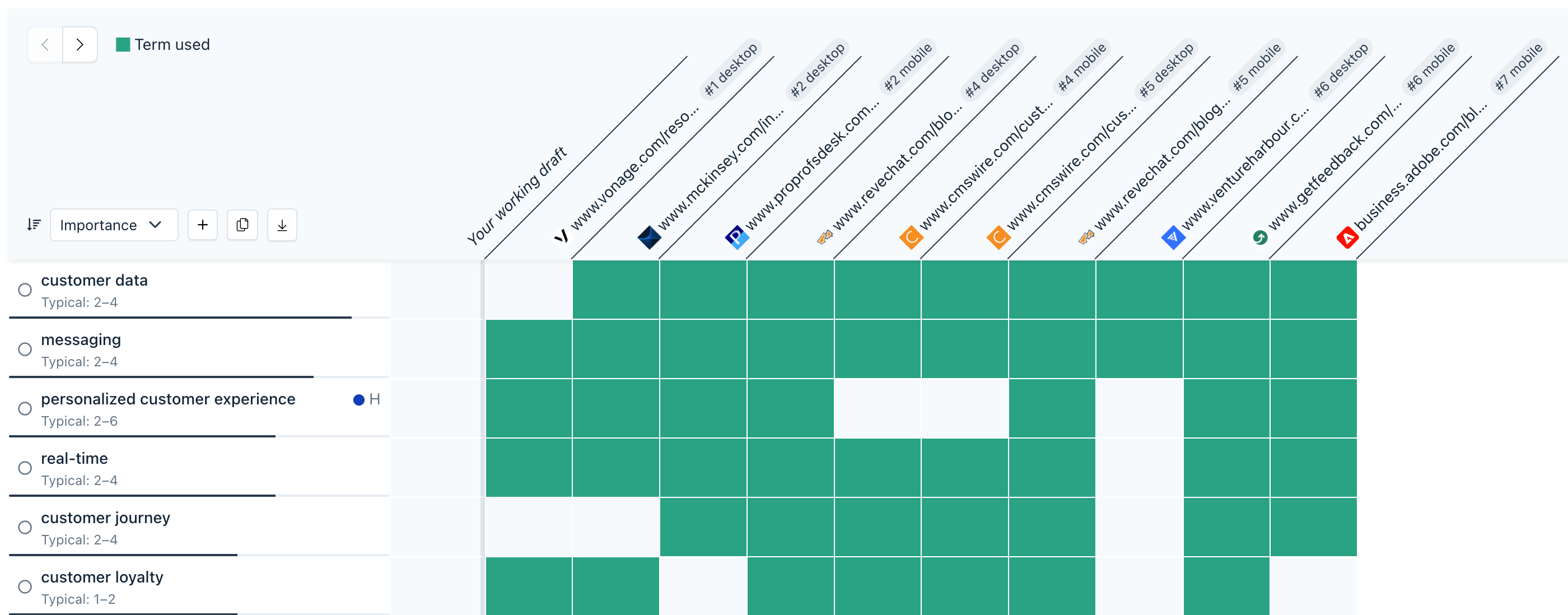
Clearscope’s term map feature for the keyword “personalized customer experience.”
Once you know what other brands are doing, you can figure out how to make your content unique. You can approach the problem differently, add expert quotes, or cover topics they missed.
3. Write in-depth content
If you want to rank on the first page of search results and earn more conversions, you need to provide value to your users. When you publish in-depth content, you demonstrate your expertise to readers and eventually help you prove trustworthiness to search engines.
Look at related topics and frequently asked questions to find the most relevant areas to expand your writing. Clearscope’s Research tab can help with this.
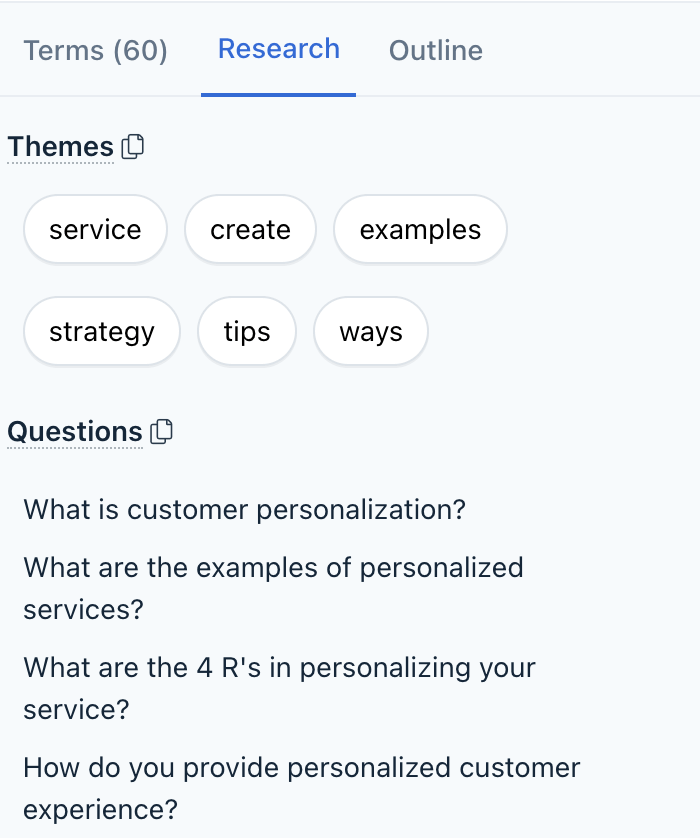
Clearscope research tab for the keyword “personalized customer experience.”
4. Optimize page title tags and URLs
Writing content that ranks highly on SERPs is an excellent first step to reaching a larger audience. But you still need users to click on your title link instead of others to improve your organic search traffic.
This is where your page title and URL can help. Page titles should be engaging (clickable) and not too long (you don’t want the search results to cut them off.)
As for your URL structure, use readable and relevant URLs to describe your page. Including your keyword in the page title and your URL slug might make it easier for search engines to display your page for the appropriate queries.
5. Write compelling meta descriptions
The meta description is another element that can help you improve click-through rates. Each piece you publish should have a unique description. It’s helpful to include the primary keyword here, too.
Ideally, your description should give readers a brief but clear understanding of exactly what they’ll get from your page content. And finally, write them in an inviting and conversational way to engage readers from the start.
6. Add engaging visuals
Breaking up long chunks of text with media can create a more pleasant reading experience.
Specifically, elements like infographics, data visualizations, and explainer videos can improve your reader’s understanding of the information. This is especially true when you want to explain complex concepts or describe how a process works.
Images that help explain concepts have appeared at the top of SERPs alongside featured snippets and answers to frequently asked questions.

Clearscope research tab for the keyword “personalized customer experience.”
That said, visuals can just as easily become distracting. Ensure they’re relevant to the text around them to get the most out of them.
You can include your target keyword in the file title, image caption, and alt text (also known as alt tags) to further optimize any media elements for video and image search results.
7. Leverage internal links
Adding an internal linking strategy to your SEO content marketing plan is an excellent way to help search engines and readers get to know your brand better.
Search engines use internal links to understand your website’s hierarchy and which topics to associate with your domain.
Readers and potential customers use internal links to explore your brand and discover other parts of your website.
When it comes to internal link building, relevance is key. You don’t want to add so many links that they distract from the content or negatively impact readability. Instead, add links to helpful content and focus them on related keywords.
8. Build topic clusters
Topic clusters are groups of content that cover a broader subject. Together, they create depth of content for the main subject. Using topic clusters to guide your content creation process can help you rank for multiple keywords supporting one topic.
Not to mention, they also help search engines understand your brand’s areas of expertise.
To build topic clusters, identify your main broad topics (these are like your pillars). Then, brainstorm and research subtopics that support each main pillar and find a target keyword for each one.
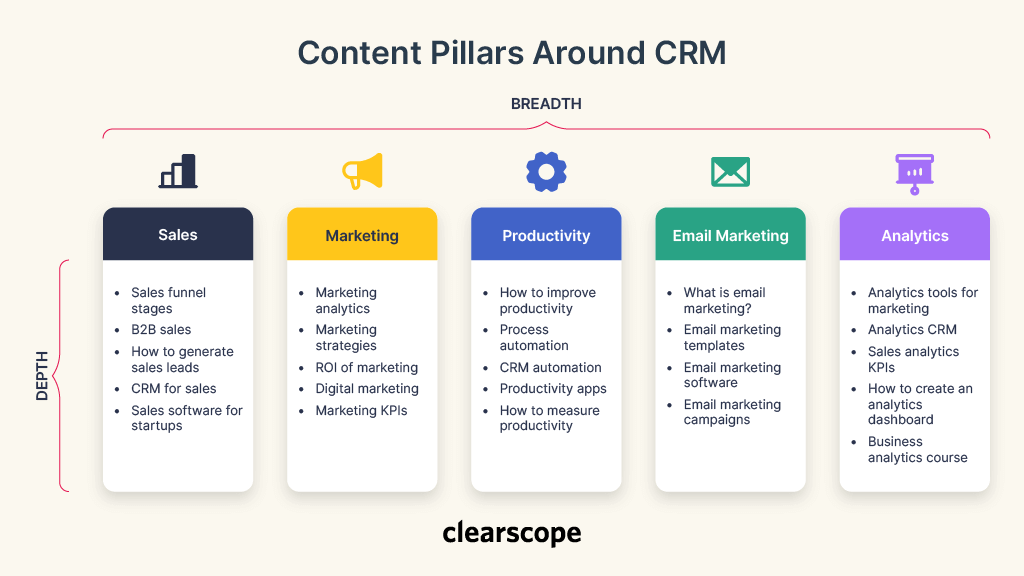
Content pillars to help build content authority around the topic of “CRM (customer relationship management).”
Building topic clusters works hand in hand with your internal linking strategy. You can also look at your existing pieces for opportunities to expand on a subtopic that you briefly discussed elsewhere.
9. Refresh existing content
User intent and the related topics for search terms can change over time. A blog post you optimized a few months ago may be missing valuable, relevant information if there’s been a change in technology or a significant related event.
Content pruning is when you identify older and underperforming pieces of content and decide which to improve and which to delete.
Clearscope’s Content Inventory feature automatically monitors your content’s performance to let you know which posts may need a refresh.
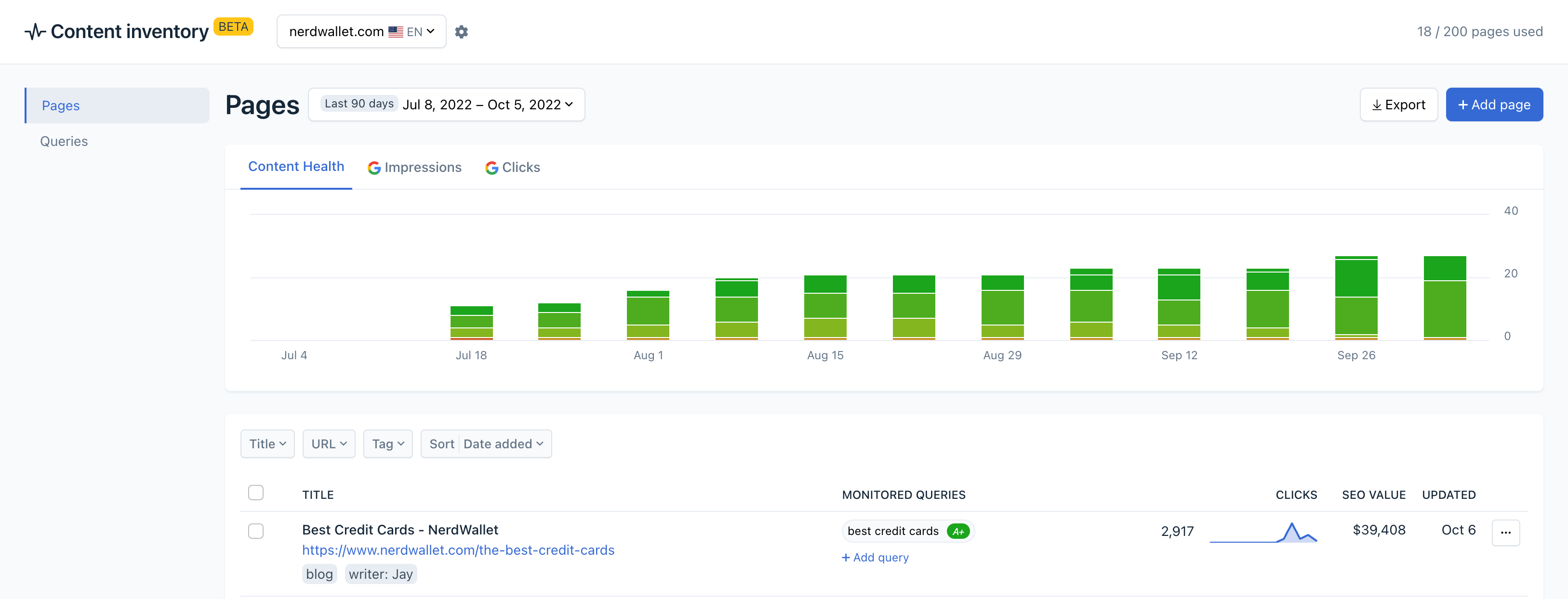
Clearscope’s Content Inventory feature.
You can run the pieces you’d like to improve through a content optimization tool like Clearscope to figure out what needs editing. Some pieces may require more work than others. Knowing how much work each piece needs helps you prioritize your refreshes.
10. Improve your website’s UX
The quality of your keyword research and content writing plays a large role in any SEO strategy. But they’re not the only main factors. Search engine algorithms are also designed to send people to websites with a positive user experience.
You can write amazing content, but if your website is slow or glitchy, it will hurt your chances of ranking.
Here are some specific areas you can focus on to make sure your website’s UX is SEO-friendly:
Your headings and subheadings are scannable
Your website navigation are logical and consistent
Your pages and images load quickly
Your content is mobile-optimized
The links in your content work
Optimizing for backlinks (off-page SEO)
Just like with on-page SEO, the key to earning backlinks is high-quality content. If you’ve followed the on-page optimization tactics above, you’ve already taken the first step to improving your off-page SEO. With that in mind, here are some extra strategies you can make use of to gain backlinks from your content and improve your site’s authority.
Provide unique insights
Include quotes from experts
Create shareable assets
11. Provide unique insights
One of the best ways to ensure that other sites will link to your content is to provide insights that readers can’t get anywhere else. This could mean focusing on new developments in a field, sharing original ideas, or including unique research and data.
12. Include quotes from experts
Not only does it add authority, the expert and their followers are likely to link to your content once it is published. You may also seek to have an expert write on a topic for your site or host a webinar.
13. Create shareable assets
Engaging visuals, such as infographics, aren’t just good for on-page SEO. They are easily shareable content that will link back to your site as the source. Likewise, informative videos and helpful downloads can also be used to attract links.
Recommend watching: Why You Shouldn't Manual Link Build by Ross Hudgens of Siege Media
Optimizing for Social Media Shares
Optimizing content for social shares is all about providing content that readers will benefit from sharing. Here are a few things to keep in mind if your primary goal is gaining traction on social media.
Write attention-getting titles
Make it quotable
Make it easy to share
14. Write attention-getting titles
A little bit of controversy can be a good thing. Writing headlines that will make users want to respond and start a conversation is a great strategy for getting shares and building your brand on social media. Be thoughtful in how you do this, though, and remember that your content should always create real value for readers.
15. Make it quotable
Just like with your title, the copywriting of your content should be engaging and make it easy for readers to pull quotes to share in their social media posts. Formatting your content to make these shareable moments stand out is also a good practice.
Recommend watching: SEO Disasters by Steven van Vessum
16. Make it easy to share
It’s a good idea to include social share buttons on your web pages and keep them visible. Likewise, make sure that the page’s meta tags contain a description and image that will be appealing on social media.
Conversion optimization strategies
If your ultimate goal is to make readers into customers, then don’t overlook conversion optimization. Whether your goal is newsletter subscriptions, signups for a free trial, or item purchases, these are tactics that can help you get more from your content.
Target the right audience
Use conversion-oriented writing
Include clear and compelling CTAs
Make the conversion path as easy as possible
17. Target the right audience
It’s important to keep in mind what stage in the funnel readers are at. The pieces of content that will be the easiest to optimize for conversions will likely be aimed at bottom-of-funnel readers. This may mean content targeting long-tail keywords and search queries for which your product offers a clear solution.
18. Use conversion-oriented writing
Once you’re sure you’re targeting the right audience, it’s important to write persuasive content that encourages readers to act. Think about your reader and figure out what type of information would help them achieve their goals.
Helpful elements include:
Examples or illustrations
Actionable advice
Suggested tools
Use cases and case studies
19. Include clear and compelling CTAs
A call to action should motivate a reader to act and also be clear about what action they are taking. For this, engaging copy that directly addresses the reader’s needs is essential.
Make it about the reader
Make it clear you’re providing the specific solution the reader is looking for and not just listing your features.
Make it contextual
Rather than using the same type of CTA with the same copy on every page, make your CTAs relevant to the content.
Include more than one
Give readers multiple opportunities to make the decision to act by placing CTAs in different parts of the content. Make sure to not go overboard though — too many CTAs can make a page seem crowded, especially on smaller screens.
Make them stand out
Design your CTAs to be eye-catching and appealing, whether they’re buttons, imagery or specially formatted text.
Recommend watching: Crazy Effective Conversion Strategies for SEO Content by Tom Shapiro (Stratabeat)
20. Make the conversion path as easy as possible
Just like with SEO, good UX is also essential for conversion optimization. You don’t want someone who is ready to take an action to experience unnecessary friction in the process. Make sure that every step in the path to completing an action makes sense and has a user-friendly design.
Final thoughts: A content optimization strategy to improve traffic and leads
An effective content optimization strategy can do much more than increase website traffic. It can help you build brand awareness and generate high-quality leads for your business.
In terms of SEO, you want search engines to understand your content. To help with that, you can improve on-page elements, make technical fixes, acquire external links, and demonstrate expertise in your content.
Depending on your current marketing needs, conversion optimization and optimizing for social shares can go hand in hand with SEO to make sure your content is reaching its full potential. Whatever types of optimization you pursue, having a strategy is essential for long-term success.

7 On-Page Optimization Tools to Create & Update Site Content
Our guide compares the best on-page optimization tools to research keywords, write SEO-optimized content, and improve rankings in Google search results.
Read moreOn-Page SEO: What it is, Why it Matters, & How To Optimize
Here’s what industry experts have to say about on-page SEO. Learn what it is, why it’s important, and how to use it to improve your organic traffic.
Read more8-Step Checklist to Optimize Blog Posts for SEO (2023 Guide)
Our guide covers 8 steps to optimize blog posts for SEO — we explain the benefits of content optimization software & SEO reports to streamline this process.
Read more